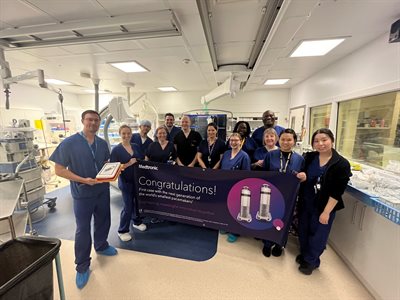New generation of miniature leadless pacemakers now being fitted at NGH

The NGH Heart Centre team on the day they fitted the new device
Northampton General Hospital has become the first hospital in the UK to start to fit a new generation of leadless pacemakers.
The miniature pacing device - which is less than 2 grams in weight – is implanted inside of the right ventricle of the heart and remains undetected to the human eye, unlike traditional pacemakers that are often seen under the surface of the skin.
Traditional pacemakers themselves help regulate the heart and have been used in cardiology for decades and smaller ones have been used for the last seven years.
However, in February NGH became the first hospital Trust in the UK to insert a new next generation of Medtronic Micra pacemakers which is leadless and has the advantage of a battery life of about 16 years - 40 per cent more than the original versions of the device.
Dr David Sharman is the Clinical Director for Cardiology across both Northampton and Kettering General Hospital, and was the cardiologist that implanted the first device.
He said: “The Micra AV2 is the next generation of leadless pacemakers and is 93% smaller than conventional pacemakers.
“It is used for patients with heart conduction disorders disorders such as bradycardia, which is a low heart rate. The device is designed to generate a pulse to keep the heart beating at regular and consistent rate.
“From a patient experience aspect, they have no chest scar, no bump in the chest from a pacing device, no visible or physical reminder of a pacemaker under the skin and fewer post pacemaker activity restrictions.
“For example they can go back to being active quicker as the recovery restrictions are not as strict or as long.”
The new device is a leadless intracardiac pacemaker that is implanted into the right ventricle of the heart via the femoral vein using a catheter. It is fitted in a hospital cardiac catheter lab and takes approximately an hour to fit.
Recovery time from the procedure is minimal and in most cases patients are able to go home on the same day as the implant.
Sister Kimberley Bruley from NGH’s Heart Centre said: “Because the pacemaker is so small we find younger people find it easer to accept the device as it leaves no wound or scarring.
“It also eliminates complications such as infection and haematomas which can occur with traditional pacemakers because the procedure is more invasive and involves fitting the pacemaker under the skin.
“In practice this new kind of device means that more than 80% of suitable patients are projected to need only one of the new leadless Micra device for life. “
Northampton General Hospital’s Medical Director, Mr Hemant Nemade, said: “I am delighted to see our cardiology team are working to bring the latest developments to our patients that help to maintain and improve their quality of life and enhance their patient experience.”
So far only three of the new pacemakers have been implanted at NGH with more patients awaiting their new device to be implanted. Suitability for the pacemaker will depend on an individual’s particular problem and what part of their heart needs support.
Posted on Monday 22nd April 2024